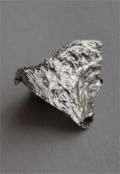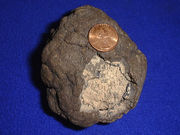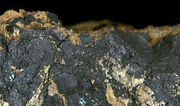Manganese Ore

 |
| Manganese. |
 |
| Manganese ore |
 |
| Psilomelane (manganese ore) |
|
| |
Manganese is a chemical element that is designated by the symbol Mn. It is found as the free element in nature (often in combination with iron),
and in many minerals. The free element is a metal with important industrial metal alloy uses.
Manganese ions are variously colored, and are used industrially as pigments and as oxidation
chemicals. Manganese (II) ions function as cofactors for a number of enzymes; the element is
thus a required trace mineral for all known living organisms.
History
The
origin of the name manganese is complex. In ancient times, two black minerals from Magnesia in
what is now modern Greece were both called magnes, but were thought to differ in gender. The
male magnes attracted iron, and was the iron ore we now know as loadstone or magnetite, and
which probably gave us the term magnet. The female magnes ore did not attract iron, but was
used to decolorize glass. This feminine magnes was later called magnesia, known now in modern
times as pyrolusite or manganese dioxide. This mineral is never magnetic. In the 16th century, the latter compound was called manganesum by glassmakers, possibly as a corruption of two words since
alchemists and glassmakers eventually had to differentiate a magnesia negra (the black ore)
from magnesia alba (a white ore, also from Magnesia, also useful in glassmaking). Mercati called
magnesia negra Manganesa, and finally the metal isolated from it became known as manganese. The name magnesia eventually was then used to refer only to the white magnesia
alba (magnesium oxide), which provided the name magnesium for that free element, when it was
eventually isolated, much later.
Manganese compounds were in use in prehistoric times; paints that were pigmented with
manganese dioxide can be traced back 17,000 years. The Egyptians and Romans used manganese
compounds in glass-making, to either remove color from glass or add color to it. Manganese
can be found in the iron ores used by the Spartans. Some speculate that the exceptional
hardness of Spartan steels derives from the inadvertent production of an iron-manganese alloy.
In the 17th century, German chemist Johann Glauber first produced permanganate, a useful
laboratory reagent.
By the mid-18th century, manganese dioxide was in use in the manufacture of chlorine. The Swedish chemist Scheele was the first to recognize
that manganese was an element, and his colleague, Johan Gottlieb Gahn, isolated the pure
element in 1774 by reduction of the dioxide with carbon. Around the beginning of the 19th century,
scientists began exploring the use of manganese in steelmaking, with patents being granted
for its use at the time. In 1816, it was noted that adding manganese to iron made it harder,
without making it any more brittle. In 1837, British academic James Couper noted an association
between heavy exposure to manganese in mines with a form of Parkinson's Disease. In 1912,
manganese phosphating electrochemical conversion coatings for protecting firearms against
rust and corrosion were patented in the United States, and have seen widespread use ever since.
In the 20th century, manganese dioxide has seen wide commercial use as the chief cathodic
material for commercial disposable dry cells and dry batteries of both the standard (carbon-zinc) and alkaline type.
Occurrence
Manganese occurs principally as pyrolusite (MnO2), braunite, (Mn2+Mn3+6SiO12),
psilomelane (Ba(Mn2+)(Mn4+)8O16(OH)4),
and to a lesser extent as rhodochrosite (MnCO3).
Land-based resources are large but irregularly distributed; those of the United States
are very low grade and have potentially high extraction costs. Over 80% of the known world
manganese resources are found in South Africa and Ukraine. Other important manganese
deposits are in China, Australia, Brazil, Gabon, India, and Mexico.
Vast quantities of manganese exist in manganese nodules on the ocean floor.
Attempts to find economically viable methods of harvesting manganese nodules were abandoned in the 1970s.